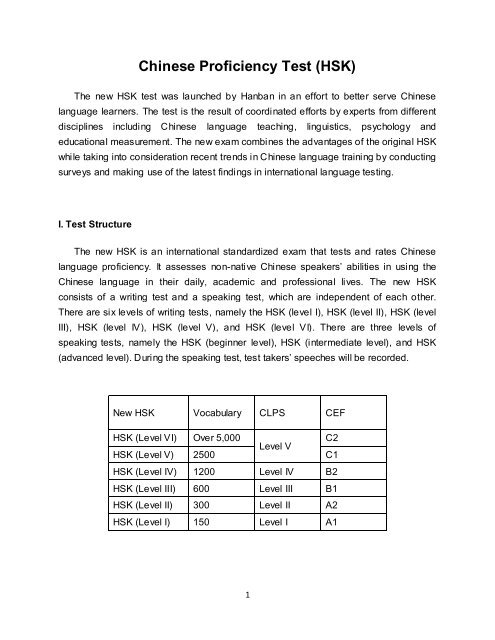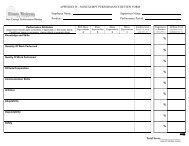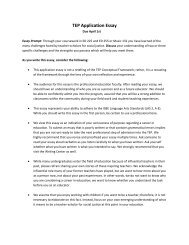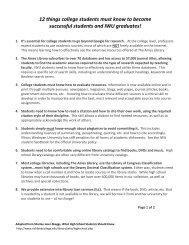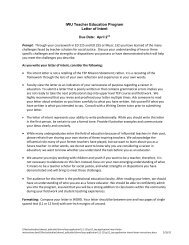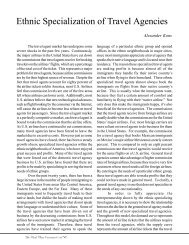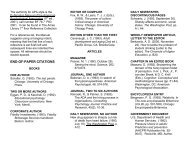Chinese Proficiency Test (HSK)
Chinese Proficiency Test (HSK)
Chinese Proficiency Test (HSK)
Create successful ePaper yourself
Turn your PDF publications into a flip-book with our unique Google optimized e-Paper software.
<strong>Chinese</strong> <strong>Proficiency</strong> <strong>Test</strong> (<strong>HSK</strong>)<br />
The new <strong>HSK</strong> test was launched by Hanban in an effort to better serve <strong>Chinese</strong><br />
language learners. The test is the result of coordinated efforts by experts from different<br />
disciplines including <strong>Chinese</strong> language teaching, linguistics, psychology and<br />
educational measurement. The new exam combines the advantages of the original <strong>HSK</strong><br />
while taking into consideration recent trends in <strong>Chinese</strong> language training by conducting<br />
surveys and making use of the latest findings in international language testing.<br />
I. <strong>Test</strong> Structure<br />
The new <strong>HSK</strong> is an international standardized exam that tests and rates <strong>Chinese</strong><br />
language proficiency. It assesses non-native <strong>Chinese</strong> speakers’ abilities in using the<br />
<strong>Chinese</strong> language in their daily, academic and professional lives. The new <strong>HSK</strong><br />
consists of a writing test and a speaking test, which are independent of each other.<br />
There are six levels of writing tests, namely the <strong>HSK</strong> (level I), <strong>HSK</strong> (level II), <strong>HSK</strong> (level<br />
III), <strong>HSK</strong> (level IV), <strong>HSK</strong> (level V), and <strong>HSK</strong> (level VI). There are three levels of<br />
speaking tests, namely the <strong>HSK</strong> (beginner level), <strong>HSK</strong> (intermediate level), and <strong>HSK</strong><br />
(advanced level). During the speaking test, test takers’ speeches will be recorded.<br />
New <strong>HSK</strong> Vocabulary CLPS CEF<br />
<strong>HSK</strong> (Level VI) Over 5,000<br />
C2<br />
Level V<br />
<strong>HSK</strong> (Level V) 2500 C1<br />
<strong>HSK</strong> (Level IV) 1200 Level IV B2<br />
<strong>HSK</strong> (Level III) 600 Level III B1<br />
<strong>HSK</strong> (Level II) 300 Level II A2<br />
<strong>HSK</strong> (Level I) 150 Level I A1<br />
1
II. <strong>Test</strong> Levels<br />
The different levels of the new <strong>HSK</strong> are similar to some of the levels in the <strong>Chinese</strong><br />
Language <strong>Proficiency</strong> Scales for Speakers of Other Languages (CLPS) and the<br />
Common European Framework of Reference (CEF); details are as follows:<br />
<strong>Test</strong> takers who are able to pass the <strong>HSK</strong> (Level I) can understand and use very<br />
simple <strong>Chinese</strong> phrases, meet basic needs for communication and possess the ability<br />
to further their <strong>Chinese</strong> language studies.<br />
Writing <strong>Test</strong><br />
<strong>HSK</strong> (Level VI)<br />
<strong>HSK</strong> (Level V)<br />
<strong>HSK</strong> (Level IV)<br />
<strong>HSK</strong> (Level III)<br />
<strong>HSK</strong> (Level II)<br />
<strong>HSK</strong> (Level I)<br />
Speaking <strong>Test</strong><br />
<strong>HSK</strong> (Advanced<br />
Level)<br />
<strong>HSK</strong> (Intermediate<br />
Level)<br />
<strong>HSK</strong> (Beginner<br />
Level)<br />
<strong>Test</strong> takers who are able to pass the <strong>HSK</strong> (Level II) have an excellent grasp of basic<br />
<strong>Chinese</strong> and can communicate in simple and routine tasks requiring a simple and direct<br />
exchange of information on familiar and routine matters.<br />
<strong>Test</strong> takers who are able to pass the <strong>HSK</strong> (Level III) can communicate in <strong>Chinese</strong> at<br />
a basic level in their daily, academic and professional lives. They can manage most<br />
communication in <strong>Chinese</strong> when travelling in China.<br />
<strong>Test</strong> takers who are able to pass the <strong>HSK</strong> (Level IV) can converse i n <strong>Chinese</strong> on a<br />
wide range of topics and are able to communicate fluently with native <strong>Chinese</strong> speakers.<br />
<strong>Test</strong> takers who are able to pass the <strong>HSK</strong> (Level V) can read <strong>Chinese</strong> newspapers<br />
and magazines, enjoy <strong>Chinese</strong> films and plays, and give a full-length speech in <strong>Chinese</strong>.<br />
<strong>Test</strong> takers who are able to pass the <strong>HSK</strong> (Level VI) can easily comprehend written<br />
and spoken information in <strong>Chinese</strong> and can effectively express themselves in <strong>Chinese</strong>,<br />
both orally and on paper.<br />
2
III. <strong>Test</strong> Principles<br />
The new <strong>HSK</strong> follows the principle of “test-teaching correlation”, bases the design of<br />
the test on the current trends in international <strong>Chinese</strong> language training, and is closely<br />
related to textbooks. The purpose of the test is to “promote training through testing” and<br />
“promote learning through testing”.<br />
The new <strong>HSK</strong> emphasizes the objectivity and accuracy of the evaluation and<br />
stresses the learners’ actual <strong>Chinese</strong> language abilities.<br />
The new <strong>HSK</strong> sets clear test objectives to allow the test takers to be able to improve<br />
their <strong>Chinese</strong> language abilities in a systematic and efficient way.<br />
IV. <strong>Test</strong>ing Purposes<br />
The new <strong>HSK</strong> retains the former <strong>HSK</strong>’s orientation as a general (or universal)<br />
<strong>Chinese</strong> language abilities test for adult learners. The results of the test can serve<br />
several purposes:<br />
1. A reference for an educational institution’s decision-making concerning recruiting<br />
students, assigning students to different classes, allowing students to skip certain<br />
courses and giving students academic credits.<br />
2. A reference for employers’ decision-making concerning the recruitment, training<br />
and promotion of test takers.<br />
3. A method for <strong>Chinese</strong> language learners to assess and improve their proficiency<br />
in <strong>Chinese</strong>.<br />
4. A method for <strong>Chinese</strong> language training institutions to evaluate training results.<br />
V. Results Certificate<br />
<strong>Test</strong> takers will receive the results for the new <strong>HSK</strong> issued by Hanban within three<br />
weeks after the test.<br />
3


